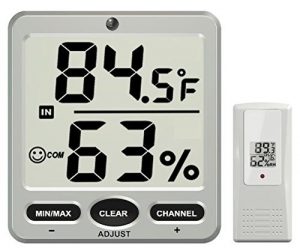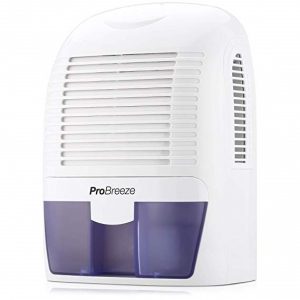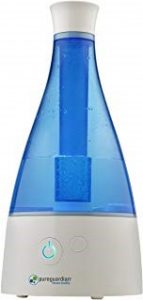Humidity Controls
Most people that have an indoor grow tent or structure of some kind are aware that temperature will affect the health and productivity of their harvest. One of the things however, that is often overlooked, is the importance of controlling humidity. From seedlings to the final product, even changes in humidity outdoors can affect humidity levels in your grow tent. While more mature plants that have established a strong root system can withstand minor changes, humidity control in a plant’s early stages are paramount.
Before you decide whether or not you will need a humidifier, you need to monitor the humidity levels within your structure. This can be easily accomplished with a humidistat (hygrometer).
Thermometer Indoor/Outdoor Digital Wireless Hygrometer
• Simple to use
• Includes indoor thermo-hygrometer in console
• Up to seven additional sensors can be added
• Includes dip switches for channel selection and units of measure (deg F vs. deg C)
The following guidelines will help you determine if humidity levels are in the proper range depending what stage your cannabis plants are in:
- Ideal daytime temperature should be 21 – 27°C (70 – 80°F)
- Night time temperatures (when lights are off) should be between 5 to 10 degrees cooler
For seedlings and young plants to end of vegetation:
40 – 60% RH (relative humidity)
For flowering plants (plant making buds):
40 – 50% RH

HELPFUL TIPS
- Wet spots forming on leaves can mean your humidity is too high or air circulation is not adequate
- Watch for mold regularly – will appear as white and powdery
- During last few weeks of flowering, lower RH levels can often increase resin production
Anything above 60% humidity levels can cause serious problems for your plants such as
- Mildew
- Mold
- Other dangerous biological growth
If any of these conditions occur, a dehumidifier may be necessary to lower the humidity within the grow room. Plants depend on taking in adequate amounts of CO2 through a process of photosynthesis which they are unable to do if the environment is too humid. A couple of examples of popular dehumidifiers are:

Frigidaire FAD301NWD
- 30-pint capacity
- Helps eliminate bacteria from air
- Continuous operation when unit located near suitable drain
- Full tank alert system
- Auto shut-off
- Energy Star Certified

Pro Breeze Electric Mini Dehumidifier
- Lightweight & Portable
- 52-ounce water tank capacity
- Can remove up to 18 ounces of water per day
- Auto Shut Off
- Ultra-quiet
- Efficient in spaces of up to 2200 cubic feet (220 sq. feet)
A typical complaint about dehumidifiers is that as the machine draws excess moisture from the air in your grow room, the water it collects must be emptied regularly. The solution to this would be to purchase a dehumidifier with an auto-drain system.
Friedrich D50BPA Dehumidifier with Built-In Drain Pump
- 50 pint capacity
- Plugs into standard 115v outlet
- Continuous drain operation
- Can pump condensation vertically or horizontally
- Displays room temperature and humidity level

If you have a humidifier that does not come with an auto-drain mechanism, you may be able to re-fit it to automatically drain. It requires several steps and the process must be followed exactly to avoid the drainage system coming into direct contact with electricity. The steps you will need to perform in order to complete this process can be found at:
How to Drain a Dehumidifier Automatically
On the other hand, if your grown room is too dry, this can also have negative consequences on the health of your plants. If this is the case, a humidifier should be added to your enclosure. Some of the more popular ones for small to medium spaces are:

PureGuardian H940 Ultrasonic Cool Mist Humidifier
- Quiet & filter free
- 6L output
- 30 hour run time
- Treated tank reduces mold
- High and low cool mist settings

TaoTronics Cool Mist Humidifier
- 4L tank capacity
- Ideal for rooms up to 10-30 m/107-322ft
- LED display
- Quiet operation
- Auto shut-off
As mentioned earlier, humidity can also be controlled to a large extent through proper ventilation. Excessive humidity can be lowered by increasing your air exchange and conversely be raised by decreasing the amount of air being exchanged within your grow room/tent.
There are a number of things that can cause humidity levels to rise such as the number of plants in your grow room. When you have too many plants for the size of your space, they will actually create ‘windbreaks’ preventing other plants from getting enough fresh air and CO2.
Increased transpiration of the plants will also occur when plant density is too high. This will translate into increased humidity. In such cases, if increased ventilation is not possible, a dehumidifier is necessary.
Temperature and air-flow play an important part in controlling the environment within your grow space. Humidity that is too high or not high enough (depending on the stage of the plant) must be monitored regularly. The health of your plants and ultimately the quality of the final yield depends on keeping the right levels of humidity and temperature within your grow tent/structure throughout the life of your plants. A hygrometer will allow you to keep a constant eye on the environmental conditions within your grow space, allowing you to make adjustments as needed.